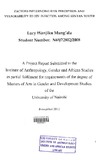| dc.description.abstract | HIV and AIDS programming for youth is surrounded by great controversy as a result of the interplay between moral discourse surrounding sexuality and the reality of sexual activities that youth engage in. The median age of sexual debut among the Kenyan youth is 17.S years for both young men and women. Significantly by agelS years, 22% of young men and 20% of young women will have had sex (NASCOP, 2008). While proper and consistent use of condoms has been shown to reduce the risk of HIV associated with unprotected sex, controversy surrounding condom access by young people continues to be a heated debate in Kenya especially among religious groups.
Gender roles that require young men to exhibit their masculinity and sexual prowess as well as generally acceptable notions on gender based violence against young women continue to put them at increased vulnerability to HIV. HIV and AIDS campaigns rarely target most at risk youth and those living with HIV and AIDS continue to be neglected by mainstream behaviour change interventions. Amid under resourced youth programmes in Kenya, there is little evidence on how best to HIV preventions programmes can respond to the needs of young people and challenge harmful social cultural behaviours that exacerbate HIV vulnerability among youth in Kenya.
The overall aim of the study is to explore attitudes towards youth sexuality, sexual risk behaviours and perceived vulnerability to HIV among young people aged IS-24 years in Kenya. This is an exploratory study that aims to provide insight on HIV risk perceptions, acquisition and transmission among youth aged IS-24years in Kenya. This project paper sets out to gain this understanding from the published literature as well as use of interviews and focus groups discussions in order to identify the above factors. Findings are presented according to the themes indentified and recommendations made.
Young people in Kenya are exposed to HIV in different ways depending on their geographic location, age, sex and educational levels. Drug and use of alcohol are also on the rise. Controversies surrounding youth sexuality continue to influence how and what type of information young people receive. This has an influence on access to services as well as service providers' biases towards providing sexual health information to young people reducing their chances of making informed decisions on matters affecting their reproductive health.
Apart from inadequate social support structures, for young people living with HIV and AIDS social stigma exists, making it difficult for them to disclose their HIV status sometimes even to their own parents for fears of being rejected. These factors are likely to have an influence on how young people negotiate for safer sex and ultimately increase their vulnerability to HIV infections amongst other consequences. Potential risks for HIV vulnerability among youth in Kenya might be reduced, through targeted non judgemental programmes that address young people's acquisition and use of condoms, availability of youth-friendly services and centres, screening and treatment for STIs/HIV.
A critical analysis of the already existing policies, forms of social support and addressing harmful social cultural practices may be the most beneficial approaches to dealing with investigations into the relationship between information and risk-taking behaviour in young people. This has the potential to confront individuals' perceptions of their personal vulnerability that is often at considerable odds with reality, not only because of misinformation but also other cultural factors or peer influence. Hence combinations of social, psychological, economic and interpersonal factors are necessary to inform youth programmes. | en_US |

